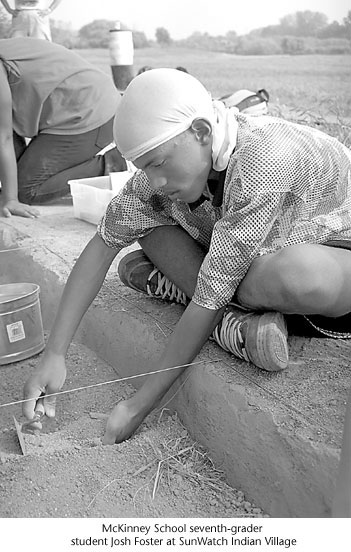McKinney
students dig up past at SunWatch
 Seeing
is believing when teaching someone about a society of humans who worked,
ate and slept 800 years ago on the land we now walk on. This month, McKinney
School seventh-grade students are experiencing that type of educational
opportunity at the SunWatch Indian Village Archaeological Park in Dayton. Seeing
is believing when teaching someone about a society of humans who worked,
ate and slept 800 years ago on the land we now walk on. This month, McKinney
School seventh-grade students are experiencing that type of educational
opportunity at the SunWatch Indian Village Archaeological Park in Dayton.
On a hot Thursday
last week, students kneeled on hands and knees around a pit of dirt in
search of reproduction shell hoes, pottery shards, post stumps and bones
like the ones once used by the 13th century Fort Ancient Indians of SunWatch
Village. The students wielded trowels and tape measures to sift through
an artificial dig site, set up by SunWatch educational staff, getting
a feel for the demanding job of an archaeologist.
"It's kind of
fun just digging and being outside barefoot," student Marissa Lite
said. "It's better than school!"
But it is school,
in the best sense, said Carla Steiger-Meister, the art teacher at Yellow
Springs High School and the McKinney School who coordinated the project
in which three groups of students took field trips to SunWatch.
"I'm more of
a humanities art teacher," Steiger-Meister said. "Studying art
out of context doesn't make sense to me."
The students involved
themselves at a hands-on level at SunWatch and learned about such things
as the origin of humans, the scientific method and ancient art, all of
which spans at least the social studies, science and art curriculums,
Steiger-Meister said. Combining the McKinney School teachers who went
on the trips with a few SunWatch education staff members gave students
a more individualized learning experience, she said.
SunWatch reconstruction
supervisor Will Irwin led Thursday's group through an introduction to
ancient history and native cultures and later helped students plot their
findings in the field on scaled graphs.
One student found
a series of flattened black surfaces at the bottom of his site. "We
figured it was a chain of post holes going to a house or some sort of
building or something," Josh Foster said.
After they finished
digging, the students took their data and the artifacts they found to
the "lab" to analyze and date each item as well as the entire
site.
"We would like
for [the students] to take away an appreciation for the past and what
goes into finding out about it," Irwin said. He emphasized the complexity
of Native American societies and the intricate process of uncovering them.
"Most kids see
Indiana Jones as an archaeologist, but he was just a pot stealer,"
he said.
The sophistication
of the ancient farmers at SunWatch can be seen in the village's method
for telling time. A tall, thick cedar post stood at the center of the
village, and twice a year it casts a shadow over the fire pit of the meeting
house, signaling the spring sowing season and the fall harvest.
The excavation site
at SunWatch was established in the 1970s and is now a national historic
landmark. Archaeologists and SunWatch staff have reconstructed several
of the reed and clay huts and part of the village's stockade as accurately
as possible. The park offers guided individual and group tours and a busy
schedule of educational events.
"SunWatch is
a gem of the Dayton area," Steiger-Meister said. "It's a great
place to learn about archaeology, and it's a spiritual place where we
can stand at the site of our ancestors."
The experience for
the students will likely be a memorable one that is applicable to future
pursuits. "If I could, I might want to do archaeology for a living,
but I also like sports," Foster said. "This is an option, if
I don't do sports, I'll probably do this."
-Lauren Heaton
|



